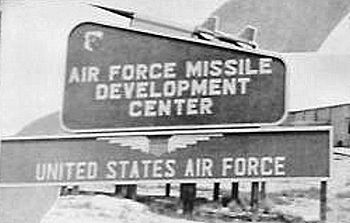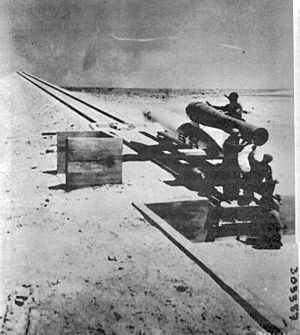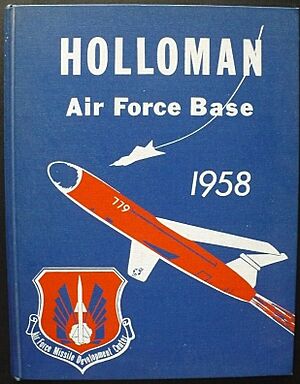Air Force Missile Development Center facts for kids
Quick facts for kids |
|
|---|---|

Air Force Missile Development Center sign in 1958
|
|
| Active | 1 September 1957-1 August 1970 |
| Country | United States |
| Branch | United States Air Force, assigned to:
with predecessors assigned to:
|
| Role | Research & Development |
The Air Force Missile Development Center was a special unit during the Cold War. It helped test many different types of missiles. This center was located at Holloman Air Force Base in New Mexico. People sometimes used "Holloman" or "Development Center" to talk about the base itself.
Contents
How it Started
Construction for a new USAAF base began on February 6, 1942. It was planned for training pilots during World War II. A nearby military testing area was also created. On May 14, 1942, this area became the Alamogordo Bombing and Gunnery Range. The base itself was first called Alamogordo Field Training Station. Later, it was named Alamogordo Army Air Base.
Early Base Operations
The 359th Base Headquarters unit started running Alamogordo Army Air Base on June 10, 1942. The base was renamed Alamogordo Army Air Field on November 21, 1942. It supported many bomber groups during World War II.
In October 1944, a special unit was formed to test captured and experimental weapons. This included the Republic‐Ford JB‐2, which was a copy of Germany's V-1 flying bomb. In June 1945, work began on the White Sands Proving Ground (WSPG) nearby.
On March 25, 1944, the 231st AAF BU became the main unit for the base. After the war, the base had only a small crew. It was mainly used for refueling planes and emergency landings.
In March 1947, missile testing began at the Alamogordo range. The special weapons testing unit moved to Alamogordo. This new unit, the 4145th Army Air Forces Base Unit, focused on R&D for pilotless aircraft and guided missiles. In 1947, a Balloon Branch also started at Alamogordo. They launched high-altitude balloons for research.
The 4145th unit was renamed an Air Force Base Unit on September 27, 1947. This was the same month the USAF was created. Later in 1947, the old bombing range and the White Sands Proving Ground joined together. They became the New Mexico Joint Guided Missile Test Range. The air base was officially named Holloman Air Force Base on January 14, 1948. The 2754th Air Force Base became its main unit.
Missile Testing at Holloman
The Alamogordo Guided Missile Test Base at Holloman AFB was used for many tests. It was a sub-base of the Air Force Missile Test Center in Florida. The 2754th unit set up more launch sites. They tested rockets like the Tiny Tim, GAM-63 RASCAL, and XQ-2 Drone.
Here are some important tests and events:
- 1947 June 5: A group of rubber balloons was launched near Alamogordo for research.
- 1947 July 3: A balloon was launched from Holloman by a New York University team.
- 1947 November 14: The first Boeing GAPA missile was launched at Alamogordo. It was the first GAPA with a ramjet engine.
- 1948 May–November: Rockets for the NATIV launch vehicle program were fired at Holloman.
- 1949 June 14: Holloman prepared the second monkey capsule for the Albert Project. This project sent monkeys into space.
- 1949: The first X–8 Aerobee rocket was launched at Holloman.
- 1950: The first test on the Holloman High Speed Test Track happened. It was for an SM-62 Snark missile.
- 1950 July 15: A long launch facility for Snark missiles was finished.
- 1950 August 29: The first balloon flights for the Aero Medical Laboratory took place.
- 1951 April 18: An Aerobee research rocket carried a monkey into space from Holloman Air Force Base.
- 1951-1952: A smaller version of the GAM-63 Rascal missile, called "Shrike", was tested.
- 1952: Balloons for Project Moby Dick were launched using a special launcher.
- 1952: Falcon missiles were fired at drone planes.
- 1954 March 19: A new, very fast rocket-powered sled was run for the first time.
- 1955 Spring: The Sonic Wind Number 2 rocket sled arrived.
- 1956 September 1: The 500th balloon launch at Holloman was completed.
- 1957 February: Testing of the XSM-73 Goose decoy missile began using the rocket sled.
- 1958: Two F-100 chase planes flew with a MGM-13 Mace missile from Holloman to Wendover Air Force Base.
The base units changed names several times. They became the 2754th Experimental Wing in 1949, then the 6540th Missile Test Group in 1951, and later the 6580th Missile Test Group in 1952. This group had a special "Aero-Medical Sub-Unit" to support medical research. In May 1952, more land was added to the testing range.
Development Centers
The Holloman Air Development Test Center (later HADC) was created from the 6580th Wing on October 10, 1952. This center supported tests for Air Force flights. It also helped prepare for future human space flights. For example, it was involved in:
- 1955: Project Manhigh, which involved high-altitude balloon flights.
- 1959–1960: Project Excelsior, another high-altitude balloon project.
- Tests with John Stapp, the first human to ride the rocket sled.
- Training Ham, a chimpanzee, who became famous for going into space in 1961.
The Air Force Missile Development Center (AFMDC) was officially named on September 1, 1957. In 1958, the joint testing range was renamed White Sands Missile Range. The 6571st Aeromedical Research Laboratory became an AFMDC unit in 1961.
Later Years
The Air Force Missile Development Center and the 6571st lab closed on August 1, 1970. Many military and civilian jobs were lost. The AFSWC's 6585th Test Group was then created. This new group continued to operate key facilities. These included the Holloman High Speed Test Track, the Central Inertial Guidance Test Facility (CIGTF), and the Radar Target Scatter Facility (RATSCAT).



